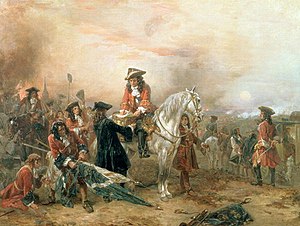
Back Slag van Blenheim Afrikaans معركة بلاينام Arabic Другая Гёхштэцкая бітва Byelorussian Битка при Бленхайм Bulgarian Batalla de Blenheim Catalan Bitva u Höchstädtu Czech Slaget ved Blenheim Danish Zweite Schlacht bei Höchstädt German Batalla de Höchstädt (1704) Spanish Blenheimgo gudua Basque
| Battle of Blenheim | |||||||
|---|---|---|---|---|---|---|---|
| Part of the War of the Spanish Succession | |||||||
 Duke of Marlborough signing the Despatch at Blenheim | |||||||
| |||||||
| Belligerents | |||||||
| Grand Alliance: | |||||||
| Commanders and leaders | |||||||
| Strength | |||||||
|
| ||||||
| Casualties and losses | |||||||
12,984
|
27,190
| ||||||
Location within Germany | |||||||
The Battle of Blenheim (German: Zweite Schlacht bei Höchstädt; French: Bataille de Höchstädt; Dutch: Slag bij Blenheim) fought on 13 August [O.S. 2 August] 1704, was a major battle of the War of the Spanish Succession. The overwhelming Allied victory ensured the safety of Vienna from the Franco-Bavarian army, thus preventing the collapse of the reconstituted Grand Alliance.
Louis XIV of France sought to knock the Holy Roman Emperor, Leopold, out of the war by seizing Vienna, the Habsburg capital, and gain a favourable peace settlement. The dangers to Vienna were considerable: Maximilian II Emanuel, Elector of Bavaria, and Marshal Ferdinand de Marsin's forces in Bavaria threatened from the west, and Marshal Louis Joseph de Bourbon, duc de Vendôme's large army in northern Italy posed a serious danger with a potential offensive through the Brenner Pass. Vienna was also under pressure from Rákóczi's Hungarian revolt from its eastern approaches. Realising the danger, the Duke of Marlborough resolved to alleviate the peril to Vienna by marching his forces south from Bedburg to help maintain Emperor Leopold within the Grand Alliance.
A combination of deception and skilled administration – designed to conceal his true destination from friend and foe alike – enabled Marlborough to march 400 km (250 mi) unhindered from the Low Countries to the River Danube in five weeks. After securing Donauwörth on the Danube, Marlborough sought to engage Maximilian's and Marsin's army before Marshal Camille d'Hostun, duc de Tallard, could bring reinforcements through the Black Forest. The Franco-Bavarian commanders proved reluctant to fight until their numbers were deemed sufficient, and Marlborough failed in his attempts to force an engagement. When Tallard arrived to bolster Maximilian's army, and Prince Eugene of Savoy arrived with reinforcements for the Allies, the two armies finally met on the banks of the Danube in and around the small village of Blindheim, from which the English "Blenheim" is derived.
Blenheim was one of the battles that altered the course of the war, which until then was favouring the French and Spanish Bourbons. Although the battle did not win the war, it prevented a potentially devastating loss for the Grand Alliance and shifted the war's momentum, ending French plans of knocking Emperor Leopold out of the war. The French suffered catastrophic casualties in the battle, including their commander-in-chief, Tallard, who was taken captive to England. Before the 1704 campaign ended, the Allies had taken Landau, and the towns of Trier and Trarbach on the Moselle in preparation for the following year's campaign into France itself. This offensive never materialised, for the Grand Alliance's army had to depart the Moselle to defend Liège from a French counter-offensive. The war continued for another decade before ending in 1714.
Cite error: There are <ref group=lower-alpha> tags or {{efn}} templates on this page, but the references will not show without a {{reflist|group=lower-alpha}} template or {{notelist}} template (see the help page).

